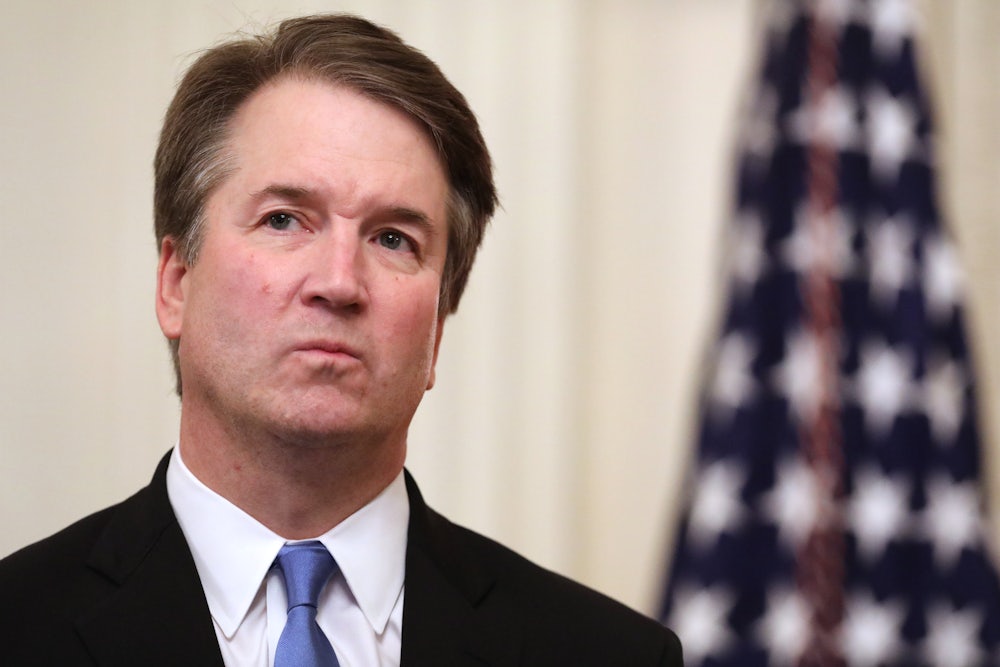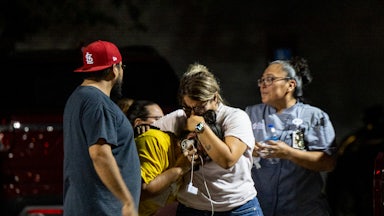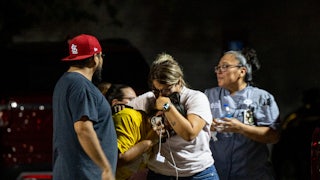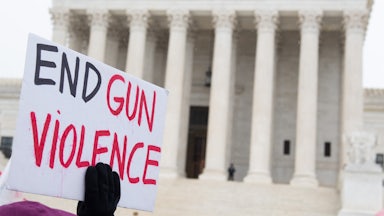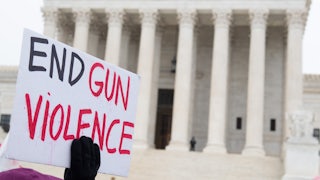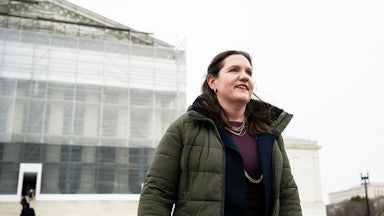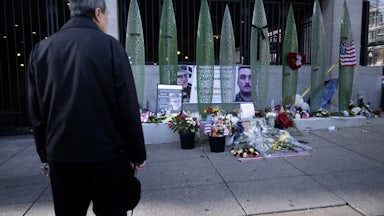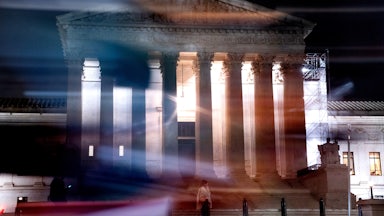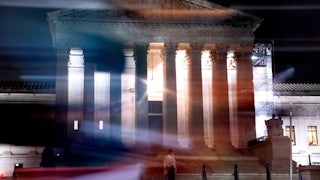Justice Clarence Thomas spent the last few years claiming that the Supreme Court was treating the Second Amendment like a “second-class right.” He thundered against his colleagues for refusing to take up cases in which the lower courts had narrowly interpreted the right to keep and bear arms. And he awaited the day when he could correct what he saw as a grievous oversight by the court on the constitutional scope of gun rights.
That day came on Thursday when the court, led by Thomas, struck down New York’s system for concealed-carry licenses in New York State Rifle and Pistol Association v. Bruen. In doing so, the court handed gun rights advocates their most significant legal victory in more than a decade. Thomas’s broadly written decision will, on its face, tilt the legal field against state and federal lawmakers who hope to reduce the prevalence of firearms in modern American life.
But this victory could prove to be more limited than Thomas hoped for thanks to one of his newest colleagues. In a concurring opinion that was joined by Chief Justice John Roberts, Justice Brett Kavanaugh effectively signaled that he would not go much further than Thursday’s ruling to upend state and local laws on concealed-carry licenses. He also expressed broad agreement with the language in Heller that suggested most of the nation’s existing gun regulations were constitutional. The two justices’ views suggest that the gun rights movement might not have five votes to read some of its most aspirational hopes for the Second Amendment.
Thursday’s 6–3 ruling in Bruen fell along the court’s usual ideological lines. Thomas said that neither the court’s precedents nor the Anglo-American legal tradition could sustain New York’s highly discretionary practice for handing out concealed-carry permits, which required applicants to show a “special need” to carry a gun in public. As some public defender groups noted in friend of the court briefs, this led to circumstances where celebrities could readily obtain concealed-carry permits while New Yorkers from less fortunate backgrounds were criminalized for simply possessing guns for self-defense.
“We know of no other constitutional right that an individual may exercise only after demonstrating to government officials some special need,” Thomas wrote. “That is not how the First Amendment works when it comes to unpopular speech or the free exercise of religion. It is not how the Sixth Amendment works when it comes to a defendant’s right to confront the witnesses against him. And it is not how the Second Amendment works when it comes to public carry for self-defense.”
Thomas also took the opportunity to upend how lower courts had interpreted the Second Amendment since the court’s landmark 2008 ruling in D.C. v. Heller, in which the justices established an individual right to bear arms for the first time. Many lower courts apply a two-step test when scrutinizing the constitutionality of gun regulations, first by looking at historical precedents of the regulation in question and then by looking at whether the state had a justified interest in passing the regulation.
“Despite the popularity of this two-step approach, it is one step too many,” Thomas wrote. “Step one of the predominant framework is broadly consistent with Heller, which demands a test rooted in the Second Amendment’s text, as informed by history. But Heller and McDonald do not support applying means-end scrutiny in the Second Amendment context. Instead, the government must affirmatively prove that its firearms regulation is part of the historical tradition that delimits the outer bounds of the right to keep and bear arms.”
At first glance, that new test could have significant implications for some laws that had been upheld over the past decade by the lower courts, including state-level bans on assault-style weapons and broad restrictions on when and how guns can be carried in public. Reining in the lower courts appears to have been Thomas’s intent. “If the last decade of Second Amendment litigation has taught this Court anything, it is that federal courts tasked with making such difficult empirical judgments regarding firearm regulations under the banner of ‘intermediate scrutiny’ often defer to the determinations of legislatures,” he said, which he opposed.
Bruen centered on two New Yorkers who sought concealed-carry permits from their local sheriff’s office. Both of them attributed their desire to obtain the permit to their general fear of local crime. Under New York law, local officials have broad discretion when deciding whether those permits can be granted. The sheriff’s office denied both applications, effectively finding that a general need for self-defense did not qualify the two men for permits. The two men then sued to overturn the law governing New York’s concealed-carry regime. Both the district court and the Second Circuit Court of Appeals sided with the state. New York successfully argued to both courts that its regulatory process fell within long-standing traditions for regulating the public carrying of weapons.
Justice Stephen Breyer, who dissented alongside Justices Sonia Sotomayor and Elena Kagan, opened by recounting a litany of statistics about the impact of gun-related violence on American society. He also criticized the court for what he saw as a flawed reading of the Anglo-American legal tradition. “Only by ignoring an abundance of historical evidence supporting regulations restricting the public carriage of firearms can the Court conclude that New York’s law is not ‘consistent with the nation’s historical tradition of firearm regulation,’” he wrote.
Much of Thomas’s majority opinion and Breyer’s dissenting opinion delve into how medieval England and early modern America regulated the carrying of guns in public. To Breyer, a variety of laws and statutes suggest that state and local authorities had broad discretion to determine when and how people could carry weapons in public. Thomas acknowledged these laws’ existence but nonetheless concluded that there was no tradition of “broadly prohibiting the public carry of commonly used firearms for self-defense.”
Breyer, writing in dissent, chastised the majority for what he saw as its misreading of the historical record. “Laws regulating the public carriage of weapons existed in England as early as the 13th century and on this continent since before the founding,” he noted. “Similar laws remained on the books through the ratifications of the Second and Fourteenth Amendments through to the present day. Many of those historical regulations imposed significantly stricter restrictions on public carriage than New York’s licensing requirements do today.”
In addition to the historical sources, Thomas also adopted a straightforward reading of the Second Amendment itself. “This definition of ‘bear’ naturally encompasses public carry,” he wrote. “Most gun owners do not wear a holstered pistol at their hip in their bedroom or while sitting at the dinner table. Although individuals often ‘keep’ firearms in their home, at the ready for self-defense, most do not ‘bear’ (carry) them in the home beyond moments of actual confrontation. To confine the right to ‘bear’ arms to the home would nullify half of the Second Amendment’s operative protections.”
Thomas’s back-and-forth with Breyer revolved around the historical sources and how they should be read. Justice Samuel Alito, who wrote a solo concurring opinion, used that opportunity to deride Breyer’s reasoning in both this case and in Heller in snarky and personal terms. “The real thrust of today’s dissent is that guns are bad and that states and local jurisdictions should be free to restrict them essentially as they see fit,” Alito commented. In another solo concurring opinion, Justice Amy Coney Barrett discussed an ongoing methodological debate over the time frame that judges should use when weighing historical contexts for constitutional rights.
But those concurring and dissenting opinions will ultimately matter less than the one written by Kavanaugh and joined by Roberts. He used the opportunity to outline what he saw as two important limits to Thomas’s majority opinion. “First, the Court’s decision does not prohibit states from imposing licensing requirements for carrying a handgun for self-defense,” Kavanaugh wrote. “In particular, the Court’s decision does not affect the existing licensing regimes—known as ‘shall-issue’ regimes—that are employed in 43 states.” (He appears to be counting the roughly two dozen states that don’t require carry permits at all in this number.)
That suggests that Kavanaugh and Roberts could be unwilling to go further than Thursday’s ruling when it comes to rewriting state concealed-carry licensing regimes through the Second Amendment. Kavanaugh wrote that Bruen only applied to “unusual discretionary licensing regimes” like the one in New York and similar “may-issue” systems in a handful of other states. He even suggested that, with some tweaks, the may-issue regimes could yet pass constitutional muster.
Then Kavanaugh dropped the hammer. “Second, as Heller and McDonald established and the court today again explains, the Second Amendment ‘is neither a regulatory straightjacket nor a regulatory blank check,’” he wrote. “Properly interpreted, the Second Amendment allows a ‘variety’ of gun regulations.” He specifically pointed to Scalia’s limiting paragraph in Heller, which has been cited by lower courts throughout the last decade to uphold most existing regulations on guns.
This is not a de jure limitation on the court’s majority opinion, to be clear. But it could represent a major de facto hurdle for future gun rights litigants to overcome. By downplaying Thursday’s ruling and doubling down on the exceptions described in Heller, Kavanaugh and Roberts appear to be signaling that they would not overturn most existing regulations on firearms. Gun rights advocates who may otherwise celebrate the court’s ruling in Bruen must also recognize that there may not be five votes to go much further on the scope of the Second Amendment. And if the last few years have made anything plain, it is that the Constitution means whatever five justices at any given time think it means.
Again, Kavanaugh’s concurring opinion does not automatically carry the legal heft of a majority opinion like the one published by Thomas. But it sends a fairly clear message about where the justices currently stand on the Second Amendment’s scope—the first such message that Americans have received from the court in more than 10 years. Thursday’s decision was closely watched by both gun rights and gun-control activists for its broader implications in Second Amendment cases. After the court found an individual right to bear arms in Heller in 2008 and applied it to the states in McDonald v. Chicago in 2010, the justices went nearly a decade without taking up another major case on the scope of that right.
While the court does not explain why it declines to take certain cases, Thomas’s dissents in recent years had claimed that the court was treating the Second Amendment with disfavor. Most observers, myself included, took that to indicate that there was a divide among the court’s conservative justices on the issue. Gun rights advocates hoped—and gun-control activists feared—that recent changes in the court’s membership would break that logjam in their favor. Kavanaugh’s concurring opinion in Bruen suggests that while the wind is in the sails for gun rights activists, there could still be some choppy seas ahead.
